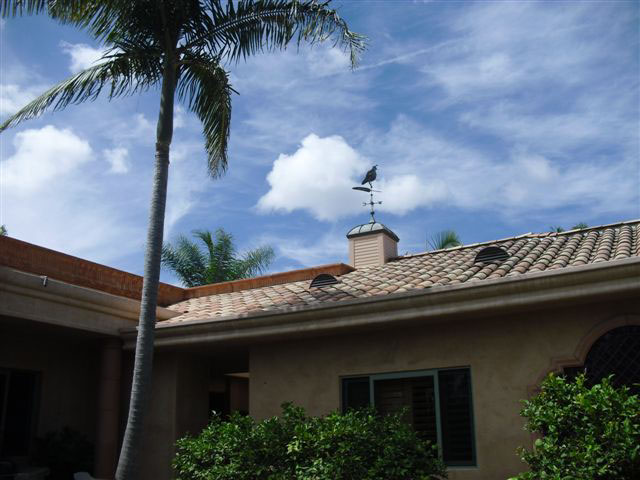Case Report: 11CA005
House painter dies when he falls through a roof opening
Download a PDF to print this report:
House painter dies when he falls through a roof opening (11CA005, PDF)
Summary
A house painter died when he fell through a roof opening on a private residence. For color matching purposes, the victim had gone up on the roof to retrieve a paint sample from a weather vane which was located on the roof of the residence garage adjacent to the roof opening. As he crossed the roof to the weather vane, he tripped and fell through the opening 15 feet to the breezeway floor below. There were no safeguards in place to prevent the fall through the opening. The work crew included the company owner, the owner's son, and the victim. They were on and off the roof several times over the past four weeks on the job. Key contributing factors identified in this investigation include unguarded roof openings, lack of employee training, and lack of a job hazard assessment to determine potential risk factors employees may encounter. The CA/FACE investigator determined that, in order to prevent falls through roof openings, employers of house painters should:
- Develop, implement, and enforce a comprehensive written Injury and Illness Prevention Program (IIPP) that includes hazard recognition, worker training in the language(s) and at the literacy level(s) of workers, and procedures on how to protect against unsafe conditions.
Introduction
On Wednesday, April 6, 2011, at approximately 9:00 a.m., a 41-year-old Hispanic house painter died when he fell 15 feet through a roof opening at a private residence. He died in the hospital the next day from his injuries. The CA/FACE investigator received notification of this incident on April 11, 2011, from the San Diego District Office of the Division of Occupational Safety and Health (Cal/OSHA). On May 4, 2011, the CA/FACE investigator interviewed the owner of the painting company and his son. On May 16, 2011, the homeowner was interviewed and pictures were taken of the incident scene.
Employer
The employer of the victim was a house painting company licensed by the California State License Board (CSLB). The company had been in business for four years. Prior to this job, the owner of the company had been the sole employee. The homeowner hired the painting contractor to power wash the exterior of the residence and to paint the trim, gates, and other areas of the home. The owner hired his son and the victim to assist with this job. It is unknown if the victim worked for this company on previous jobs.
Written Safety Programs and Training
The painting company did not have a written safety program or an Injury and Illness Prevention Program (IIPP). In addition, the company did not provide safety training to their employees in English or Spanish.
Worker Information
The victim was a friend of the owner of the painting company. He was a 41-year old Hispanic male who was born in Mexico and had been in the United States for 24 years. He had a sixth grade education and spoke only Spanish. The victim had worked as a house painter for the past ten years.
Incident Scene
The location of the incident was a custom-built single-story private residence that was undergoing renovations to the exterior. A breezeway connected the house to the garage. There was a permanent 3 x 5 foot opening in the roof of the breezeway that served only as an architectural element. Additional work was being done on the home by other contractors.
Weather
On the day of the incident, the weather was mostly overcast with a temperature of 62 degrees. Visibility was approximately 9 miles with a southerly wind speed of 8 miles per hour.
Investigation
On the morning of the incident, the crew planned to paint the weather vane, which was located on the roof of the garage, immediately adjacent to an opening (see Exhibits 1 & 2). In order to match the paint sample, the victim climbed a ladder and walked across the roof to the weather vane. As he neared the roof opening, he tripped and fell forward through the opening 15 feet to the floor below. The owner of the painting company and his son saw the victim fall through the opening and ran to his assistance. Workers from one of the other contractors onsite heard the fall and called 911. The fire department and paramedics were contacted and arrived within minutes of the call. The victim was air lifted to a local hospital where he died from his injuries the following day.
Contributing Factors
Occupational injuries and fatalities are often the result of one or more contributing factors or key events in a larger sequence of events that ultimately result in an injury or fatality. The CA/FACE investigator identified the unguarded roof opening, lack of a job hazard analysis prior to the start of the job to determine potential risk factors, and the lack of training as contributing factors in this incident that ultimately led to the fatality.
Cause of Death
The cause of death according to the death certificate was blunt force head injuries.
Recommendations
In order to prevent falls through roof openings, employers of house painters should:
Recommendation #1: Develop, implement, and enforce a comprehensive written Injury and Illness Prevention Program (IIPP) that includes hazard recognition, worker training in the language(s) and at the literacy level(s) of workers, and procedures on how to protect against unsafe conditions.
Discussion: In this incident, the employer did not have an IIPP or any safety training program that included recognition of fall hazards. Employers should evaluate all tasks performed by workers, identify all potential hazards, and then develop and implement an IIPP that meets applicable state OSHA standards. The IIPP should include an explanation of worker rights to protection in the workplace, safe work practices, specific safety protection for all tasks performed, ways to identify and avoid hazards, and who they should contact when safety and health issues or questions arise.
Employers should conduct a worksite hazard evaluation to identify the potential hazards to which workers are exposed so that appropriate preventive measures for these hazards can be identified and appropriate control measures implemented. In this incident, the employer should have identified the potential for falls through the unprotected roof opening over the breezeway to the house. Training in recognizing and avoiding hazards must be given to all workers, coupled with employer assessment that workers are competent in the recognition of hazards and safe work practices. When the victim was hired, he did not receive any type of formal safety training by the employer. The victim was provided verbal instructions on what was to be painted, but not how to work safely and avoid hazards such as unprotected roof openings. The training program content and the names and dates of employees completing the training should be documented and retained by the employer. Employers should also ensure that the trainer who provides training is qualified through education and/or experience to conduct the training. To ensure the effectiveness of the safety training, an employer should consider ways to ensure that the worker understands the important information (e.g., written testing, verbal questions, or demonstration). Additionally, employers should provide periodic refresher safety training which may be done by conducting on site toolbox type meetings.
A fall protection plan in this incident should have included the use of personal fall protection equipment, guardrails around the roof opening, or if these were not feasible, a safety monitoring system. The use of a "traditional" safety belt/lanyard combination is sometimes not practical during construction operations, particularly where worker mobility is required. Use of a retracting lifeline equipped with a locking device, and attached to a support line, can provide sufficient mobility in some cases. In this case, the work was being done 15 feet above a floor. A retracting lifeline connected to a safety line probably would have prevented this fatality. Alternative forms of worker protection, such as safety nets or a catch platform, should be considered. Safety nets can effectively prevent injury or death when a worker falls. The use of alternative fall protection systems must be carefully considered, regardless of what height is involved. If these safeguards had been in place, the victim would not have been able to fall through the roof opening to the ground below.
Overcoming language and literacy barriers is crucial to providing a safe work environment for a multilingual workforce. Companies that employ workers who do not understand English should identify the languages spoken by their employees, and design, implement, and enforce a multilingual safety program. Safety program materials and training curricula should be developed at a literacy level that corresponds with the literacy level of the company's workforce. Employers should ensure that employees who do not speak English or have limited use of English are provided an interpreter who can clearly convey instructions and ensure that employees clearly understand the instructions given.
Exhibits

Exhibit 1. The custom-built home involved in the incident.

Exhibit 2. The weather vane on top of the garage.

Exhibit 3. The breezeway entry where the victim fell through the opening in the roof.

Exhibit 4. The breezeway from the rear of the house.

Exhibit 5. The roof opening as seen from below.

Exhibit 6. The roof opening and the weather vane mounted on the residence garage.
Acknowledgement
CA/FACE would like to thank and acknowledge the San Diego District Office of Cal/OSHA for their assistance with this report.
References
California Code of Regulations -Subchapter 4
Construction Safety Orders
Article 3 -General
§1509. Injury and Illness Prevention Program
§1510. Safety Instructions for Employees
§1511. General Safety Precautions
Article 19 -Floor, Roof, and Wall Openings
§1632. Floor, Roof, and Wall Openings to Be Guarded
Preventing Falls of Workers through Skylights and Roof and Floor Opening - National Institute for Occupational Safety and Health (NIOSH) Publication Number 2004-156
Worker Deaths by Falls - NIOSH Publication Number 2000-116
Compliance Assistance Resources for Hispanic Employers and Workers - Occupational Health and Safety Administration (OSHA) website
Authors
Hank Cierpich, FACE Investigator
Robert Harrison, MD, MPH, FACE Project Officer
Laura Styles, MPH, Research Scientist
May 18, 2012